Cutex
In 1911, Northam Warren began selling Cutex, a liquid preparation that removed dead cuticle tissue without the need for cutting – hence the name ‘Cut-ex’. Northam Warren was not the first person to sell a product like this; for example, Miller’s Cutic-Off – “No knife, pain, infection or acids” – had been on sale from 1909 at the latest.
See also: Northam Warren
Cutex was originally made available as samples handed out to professional manicurists and hairdressers. Their feedback allowed Northam Warren to adjust the remover’s strength and keeping qualities before it went on general sale at fifty-cents a bottle. After its general release, the original product was quickly followed by a smaller-sized bottle and a kit that contained the cuticle remover, an orange stick and some absorbent cotton (Kavanagh, 1923).
Cutex was analysed by the American Medical Association (AMA) a few years after it appeared on the market. Some removers of the time used a weak acid to help remove the cuticle but the AMA determined that Cutex used a weak alkaline solution of potassium hydroxide and sodium hydroxide instead to soften the skin, with glycerine added to reduce irritation and rose oil included as a perfume (Street, 1917, p. 68). The use of the harsher sodium hydroxide was later dropped from the formulation.
Never cut the cuticle. Cutting only thickens it and increases the growth. Simply apply CUTEX with an orange stick, and the ragged surplus cuticle disappears and leaves the nail with that clean, sharp outline so much desired.
Anyone can use CUTEX at home. It saves time and labor for the professional manicure as well. CUTEX CONTAINS NO ACIDS, and so is absolutely harmless.(Cutex advertisement, 1912)

Above: 1922 A billboard for Cutex Cuticle Remover on the Boardwalk in Atlantic City, New Jersey.
Cutex sales were later extended to include department and drug stores as well as manicure parlours. Northam Warren started with an all-male sales force but hired women when he realised that trained female manicurists generally did a better job of promoting Cutex in beauty parlours, barbers and other places where professional manicures were done.
We used classified ads of “Manicure Girls Wanted” and weeded out the applicants. With a rather careful training in the office, these girls went out and met the operators in the beauty parlors very successfully. Their strong point was the fact that they could talk the girls’ own language—could bring out just the point which the manicure girl wants to know, and which no ordinary salesgirl could ever discover.
(Bliven, 1917, p. 39)
Early Cutex products
When the cuticle remover proved to be a commercial success, Northam Warren added other products, gradually building up a complete manicure range all badged under the Cutex brand. By 1916, this included manicure implements – like flexible steel files, emery boards, orange sticks and cotton wool – along with a range of nail polishing preparations, nail white, nail bleach and nail rouge. These were sold individually or as part of a manicure kit.

Above: Front and back of an early Cutex Nail Polish Cake showing packaging colours and products available.
Cutex Cuticle Remover: “An ideal cuticle remover. This excellent preparation which is absolutely harmless, removes ragged and surplus cuticle without cutting.”
Nail White: “A snow white cream for removing stains under the nails and whitening nail tips.”
Cuticle Comfort: “[A] salve for the relief of lacerated, dry or irritated cuticle, hang-nails and brittle finger nails, both cooling and healing.”
Nail Polishing Cake: “Gives a brilliant lasting polish with little effort. Free from grit and is absolutely harmless. In Pink and White.”
Nail Polishing Powder: “Same product as above only in powdered form.”
Polishing Paste: “Produces a quick, brilliant waterproof polish and leaves no dust around the nail.”
Liquid Nail Enamel: “For imparting an instantaneous brilliant and lasting polish to the nails. Can be used without fear of injury to the nails.”
Nail Rouge: “A rouge in concentrated salve form for tinting nails, lips and skin.”
Nail Bleach: “A white powder for removing stains and discoloration.”
J. Walter Thompson
Northam Warren had been placing small advertisements for Cutex in newspapers since 1912 but his annual advertising budget had been modest, going from US$2,600 in 1912 to US$7000 by 1915. In 1916, he took a gamble and engaged the services of the J. Walter Thompson (JWT) agency to run a national campaign for Cutex with a budget of US$40,000.
The Cutex campaign developed by J. Walter Thompson was designed by a woman, Helen Lansdowne Resor [1886-1964], one of J. Walter Thompson’s chief copywriters. It followed lines similar to the one Resor had developed for Pond’s Cold and Vanishing Creams with most of the early advertisements being educational in tone. The early copy concentrated on explaining how Cutex Cuticle Remover was to be used, why it was preferable to cutting the cuticle with scissors, and how to do a complete manicure with Cutex products.
The new way to manicure.
First, file your nails to the proper length and shape. The best professional manicurists say that it is now considered good form to give the nail an oval shape—that is, to have it conform to the shape of the finger tip, and to have the nail reach just to the top of the finger.
In the Cutex package you will find an orange stick and absorbent cotton. Wrap a little cotton around the end of the stick and dip it into the Cutex bottle. Then work the stick around the base of the nail, gently pushing back the cuticle. Almost at once you will find you can wipe off the dead surplus skin. Rinse the hands in clear water.
Then a touch of Cutex Nail White—a soft, white cream which removes all discolorations from underneath the nails.
Cutex Nail Cake rubbed on the palm of the hand and passed quickly over the nails, gives them a delightful polish. Should you wish an especially brilliant, long-lasting polish, apply Cutex Polishing Paste first, then the Nail Cake.(Cutex advertisement, 1916)
Apart from 1923, when the account went to A. J. Ayer & Son, J. Walter Thompson remained the advertising agent for Northam Warren until 1946.
Cutex is a liquid cuticle remover, which makes cutting of the cuticle unnecessary. It is the first product of its kind on the market, and while there are two or three competitors now in the field, they have never been equal to Cutex.
It was put on the market in 1912, and for the first two years, no attention was paid to advertising. In 1914 and 1915, they used small space in Harper’s Bazaar, Vogue and Ladies’ Home Journal, also newspapers in New York and Chicago in a small way. By the beginning of 1916, by good sales work, a representative distribution had been secured in cities of 25,000 and up throughout the country.(J. Walter Thompson Co., 1916)
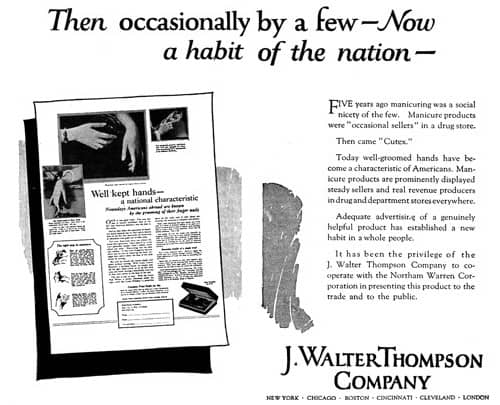
Above: 1921 JWT promoting the success of their Cutex campaign.
As customers became more familiar with the product, the tone of Cutex advertising shifted from educational towards messages about the importance of having well-manicured hands, followed by product endorsements from actresses and society women, a tactic J. Walter Thompson also used to promote Pond’s.
J. Walter Thompson also developed new designs for the Cutex bottles and packages. The redesign, completed by 1917, took its inspiration from European styling and used pink and black colours to make the line stand out on the shelf.
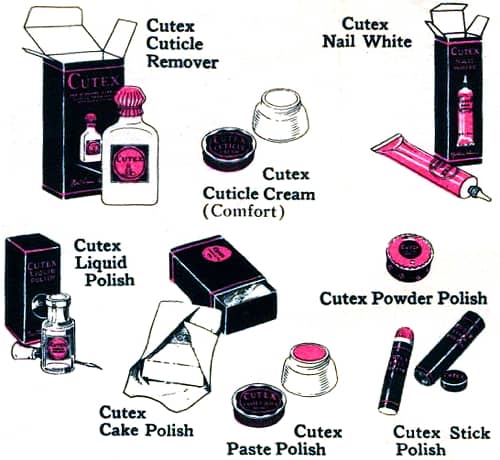
Above: 1924 Redesigned Cutex packaging in pink and black.
A new range of manicure sets was also developed named the Compact, Traveling, Boudoir and De Luxe Sets. The composition and naming of these manicure sets changed frequently over the years.
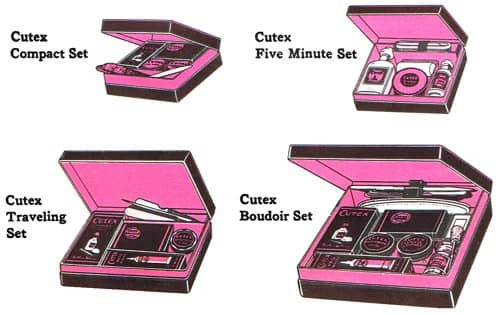
Above: 1926 A range of Cutex manicure sets.
Compact Set: Contains a nail file, emery boards, orange stick, cotton and small sizes of Cutex Cuticle Remover, Cake Polish, Paste Polish and Nail White.
Five Minute Set: Contains emery boards, orange stick, absorbent cotton, Cuticle Remover, Powder Polish and Liquid Polish.
Marquise Set: Contains Cuticle Remover, Liquid Polish, Cake Polish, Nail White, a buffer, orange stick, cotton, a nail file and emery boards.
Traveling Set: Contains a nail file, emery boards, orange stick, cotton and full sizes of Cutex Cuticle Remover, Cake Polish, Paste Polish and Nail White.
Smaller sets proved to be particularly popular as they could be carried about and later designs were made so that they could be transported safely.
Liquid nail polish
Cutex had a range of abrasive polishes in cake, paste, powder and stick forms, some of which have already been mentioned.
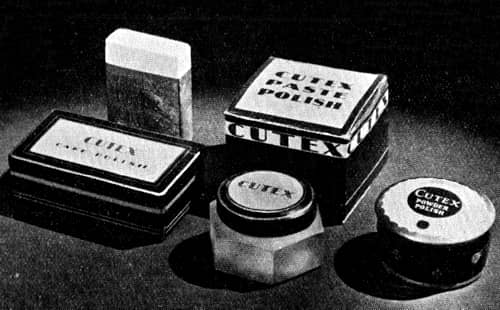
Above: 1935 Cutex Cake (package and product), Paste (jar and package) and Powder (package) Polishes.
Cake Polish: “A compact cake polish—the old favorite. Velvety smooth does not break or crumble—very economical. Rub a little on the palm of one hand, pass the nails of the other hand lightly, swiftly, over the powdered palm. In a moment you have nails that are noticeably lovely. Pink or white.”
Paste Polish: “An especially smooth paste—easily distributed over the nail to give an even polish. Tints the nails and produces a brilliant finish. Waterproof, lasting—washing actually improves the polish. Pink or uncolored.”
Powder Polish: “Instantaneous! Convenient to carry! Easy to use! At last a powder polish without messy spilling. Shake a little onto the palm of one hand, use it as a buffer, brushing it lightly, quickly, over the nails of the hand. A quick gleaming polish that is the most brilliant of all.”
Stick Polish: “A successful stick polish—one that really gives you the brilliance you demand.”
In 1916, the company introduced a clear, liquid nail polish it referred to as a Nail Enamel or Nail Polish. The following year it added a rose-tinted form and, by 1921, both products were described as nail polishes or liquid polishes. It is difficult to know whether or not Cutex made its own nail polish but I suspect that by the 1930s it may have been getting nail polish and other products from the American Beauty Nail Polish Co., Inc., New York.
Liquid Polish: “Spread this rosy liquid evenly over the surface of your nails. In a moment it dries, leaving no stickiness and no odor. No rubbing, no buffing—quick, easy and the result a sparkling jewel-like brilliance, that lasts for a week or more.”
Northam Warren did not think that these liquid polishes would be major sellers and they were not promoted as much as the abrasive polishes. However, on a trip to France in 1920, he noticed that Parisians preferred liquid nail polish over all other forms and by the time he return to America he had decided to follow this trend.
We have learned, also, to anticipate in a measure the preferences of the public as to the form of our products. As an example, the logical form of nail polish is the cake, and we were, for a time, inclined to manufacture it as our leading polish. It is easy to apply and has several advantages in its favor. But I was in Paris during 1920, and I noticed that there were dozens of different makes of liquid polish and that they were outselling all other forms. So when I returned we decided that the American preference would follow that of France. We increased our advertising on liquid polish, and it has outsold all of our other polishes.
(Warren, 1922, p. 394)
Consequently, Cutex dramatically increased its advertising for liquid polish, added it to the Introductory Manicure Set in 1921, and improved its formulation in 1922. Sales rose steadily. The packaging was also improved. The polish was first sold in a sealed corked bottle, with a separate brush but, by 1923, the brush was packaged attached to its own cork so that after the seal was broken it could be fitted into the bottle.

Above: 1926 Cutex Liquid Polish with corked brush.
In 1931, the separate corked brushes were replaced brushes built into the Bakelite caps which replaced the older seals, a design more in tune with nail polishes in production today.

Above: 1931 Cutex Nail Polish with brush built into the Bakelite cap.
The nail polish was not complemented with a specialist polish remover until 1926. Before then, it was removed with a drop of liquid polish that was wiped off before it dried along with the old polish.
The new Cutex Liquid Polish … is of just the right consistency to flow evenly and pleasantly over the nails from the tiny camel’s-hair brush with which it is applied. It dries instantly, and leaves a charming rose-petal finish that retains its brilliant lustre for at least a week. And, best of all, when you wish to renew it, no special “remover” is required. You simply use another application of the polish, and wipe it off.
(Cutex advertisement, 1922)
Cutex also generated interest in the liquid polish by altering the manicure instructions that came with its other products so that they now included the use of the liquid polish. The example below is from 1926.

Above: “First shape the nails with a steel file holding the file loosely and working upward from the sides to the centre. Then smooth off all remaining roughness with an emery board.”
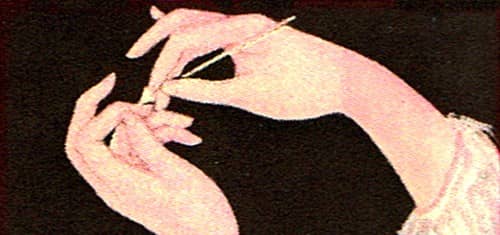
Above: “With an orange stick dipped in Cutex Cuticle Remover work around the nail groove and underneath to tip of the nail. Then rinse, and wiping push the cuticle gently downwards. The ugly, dead cuticle will simply wipe away leaving the nail rims smoother, more even than you have ever been able to make them by cutting.”

Above: “Then the polish—spread it on the soft part of the hand and burnish by brushing the nails lightly across it. To apply the liquid, coat each nail lightly with the little camel’s hair brush that comes in the box.”
In 1928, a ‘plum blossom’ fragrance was added and the new preparation was sold as Perfumed Cutex Liquid Polish even though, only three years later, Cutex advertisements were arguing against the use of scent.
Notice how true this is when you brush a gleaming film of Cutex Polish over your own oval nails. There’s a swift little whiff of the clean distinctive odor you have always associated with an efficient polish. It lasts just long enough to accomplish its task. Then—it’s gone!
No odor of any kind lingers! No alien perfume to contend with … and perhaps destroy … your own exclusive scent. Just a sparking crystal film … sparking and unscented.(Cutex advertisement, 1931)
Liquid polish colours
The first coloured Cutex Nail Polish, later referred to as a Natural (i.e., light pink) shade, was probably tinted with a soluble dye like carmoisine or safranine. A deeper tint called Deep Rose was introduced in 1925. In 1928, the company also began selling its Clear (colourless) polish with a separate bottle of tint to enable colour to be added by personal preference, a reflection of the conservative nature of many Cutex customers.
In 1930, following the move to darker nail polishes in Europe, three new shades were added: Coral, a red pink; Cardinal, a flame red; and Garnet, a red-lily red. This bought the total number of Cutex Liquid Polish shades to six, with a seventh shade, Ruby, a red red, added in 1933. All of these shades were created with dyes, so were somewhat transparent.
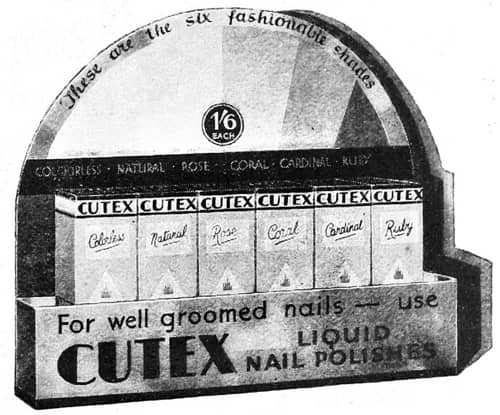
Above: 1933 Cutex shade display (Britain).

Above: 1934 Cutex Color Selector counter display. The base was moulded plastic, surmounted by a finger rest. Over the finger rest was a disk which contained transparent nail shaped sections of the six Cutex colours – the Clear shade not being included. By pushing a button on the rest and rotating the disk, the customer could see how each shade looked on their finger.
When the new colours were added in 1933, Northam Warren began to provide advice about what shade of nail polish would best coordinate with differently coloured clothing. Women could even purchase a Cutex Color Wheel for 10¢ that would give the correct shade of polish for every colour of gown. This vogue was a few years behind Paris fashions which had been recommending this sort of colour coordination since 1930 at the latest.
Natural goes with all costumes but best with bright colors—red, blue, bright green, purple, orange, yellow.
Rose is subtle and charming with pastel pinks, lavender blues … with green, black and brown.
Coral nails are bewilderingly lovely with white, pale pink, beige, gray, “the blues,” black and dark brown … daytime or evening frocks.
Cardinal contrasts excitingly with black, white, or any of the very pale shades. Good with gray or beige … the new blue.
Garnet, smart with the new tawny shades, cinnamon brown, black, white, beige, gray or burnt orange.
Ruby is such a real red red, you can wear it with anything when you want to be gay and dashing.(Cutex advertisement, 1933)
Expansion
In addition to growing within the United States, Cutex was also expanding into other countries starting with Canada distributed through MacLean, Benn & Nelson Ltd., Montreal, with a subsidiary established at 200 Mountain Street, Montreal in 1919. Expansion continued into England, Europe and South America and then, in the ensuing years, to Asia and Africa, making Cutex a global brand.
Lipstick
A second fashion trend that had become evident in Paris by 1930, was to match nail polishes with lipsticks. By 1930, Glazo had already introduced Flame, Geranium and Crimson shades of nail polish to match light, medium and dark red lipsticks and Peggy Sage had done the same with their Palm Beach Coral, Biarritz Red and Lido Crimson polish shades.
Achieving a colour intensity in nail polish that matched a lipstick was difficult to do using dyes alone and the fashion trend to match lipsticks led to greater use of opaque pigments – such as titanium dioxide and iron oxides – in nail polishes. As these polishes were opaque rather than transparent they were generally referred to as creams or cremes. The 1930s would be marked by a transition to this type of polish, the form that dominates the market today.
See also: Nail Polishes/Enamels
Although these opaque or cream nail polishes had been made for many years by Glazo, Peggy Sage and others, Cutex did not introduce its version, Cutex Crème Nail Polish, until 1934. The conservative nature of Cutex in the 1930s is probably a reflection of the taste of their American customers. Even as late as 1955, colourless nail polish was still the largest selling ‘shade’ in the United States.

Above: 1934 Cutex CrèmePolish.
In 1935, Northam Warren introduced lipsticks into its Cutex line. These were housed in rectangular push-up containers and came in four shades: Natural, Coral, Cardinal and Ruby. Each lipstick was matched with a nail polish of the same name except for Natural which could be matched with either Natural, Rose or the new Mauve shade added in 1934. The matching nail polishes originally came in both transparent and cream forms but, by 1940, transparent shades seem to have been largely phased out.
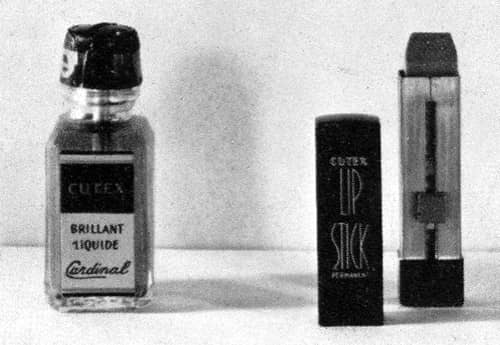
Above: 1935 Cutex Liquid Polish in Cardinal shade and matching lipstick in a push-up case.
The fashion of matching lipsticks and nail polish would prove to be a problem for Cutex in the long run. As matching lipsticks and nail polish became an established fashion trend during the 1930s and 1940s it became necessary for any cosmetic company making a line of lipsticks to produce nail polishes in matching colours as well. This, and the greater acceptance of the use of nail polish on both fingers and toes, led to more competitors in the nail polish market, the most aggressive being Revlon.
Revlon
The Revlon Nail Enamel Company was founded in 1932 by Charles Revson [1906-1975], Joseph Revson [1905-1971] and Charles Lachman [1897-1978],. The nail polishes it sold were of the cream, opaque type. Northam Warren only began selling this type of polish in 1934 and this helped give Revlon an opening. However, there are indications that part of the problem for Cutex was an industry-wide antagonism to its dominance in the market.
As Revlon entered the retail market, a number of forces were operating to make a new competitor and a change in status very welcome to a major part of the retail trade. Certain deep antagonisms existed in the mind of the retail trade and certain basic dissatisfactions with the policy of a predominant supplier. Throughout the retail trade there was an eager expectation for someone vigorous, with a new idea that could be picked up, accepted and promoted as a foil to this other company. Revlon stepped into this fortunate retail situation at the precise psychological moment with a new product and a new sales idea. The result is history in this industry.
(Nail enamel, 1958, p. 458)
Revlon’s sales strategy targeted salon manicurist, much as Cutex had done years before, and then moved into department stores and better drug stores in the prestigious end of the retail market. By the late 1930s, through its innovative marketing campaigns and by restricting its sales to department stores, better drug stores and manicure establishments, Revlon was rapidly achieving a glamorous and fashionable status with a wide shade range.
See also: Revlon
Cutex responded to Revlon’s encroachments as best as it could. Between 1934 and 1939, the year Revlon introduced its first lipstick, Cutex extended its shade range adding: Mauve, Vermillion, and Mahogany (1934); Robin Red, Rust, Light Rust, and Old Rose (1936); Clover, Tulip and Burgundy (1937); Thistle, Heather, and Laurel (1938); and Orchid, Gadabout, Hijinks, Riot, and Cameo (1939). A number of these shades, described as ‘smoky’, were similar in tone to shades offered by Revlon.
Beginning in 1938, Northam Warren also paid a number of French designers to endorse some of these shades in the hope that this would link Cutex shades with Paris fashions and give them a greater cachet.
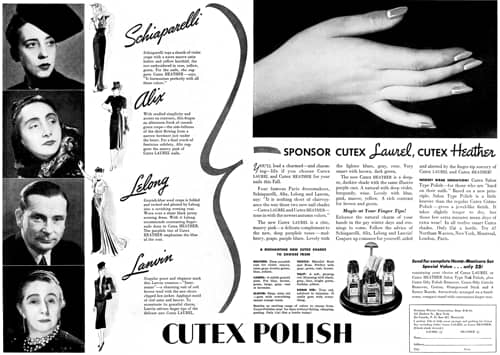
Above: 1938 Designer endorsements from Elsa Schiaparelli (1890-1973), Alix Barton (1903-1993), Lucien Lelong (1889-1958) and Jeanne Lanvin (1867-1946).
Cutex also extended its range of manicure preparations during the decade. It had already added Cutex Polish Remover, Cutex Cuticle Cream and Cutex Cuticle Oil in 1927 and these were followed by Cutex Nail White Pencil (1931), an alternative to the older tube and orange-stick method; Cutex Hand Cream (1932), which superseded the original Cutex Cold Cream, first introduced in 1919; Cutex Oily Polish Remover (1934); Cutex Oily Cuticle Remover and Cutex Brittle Nail Cream (1936), to help restore natural oils; Cutex Polish Foundation (1938), a clear colourless liquid applied before the nail polish to protect the polish from chipping; Cutex Nail Shampoo (1939), to remove ink stains; Cutex Porous Nail Polish (1940), to help brittle and splitting nails; and Cutex Overcoat (1941), a quick drying finish.
In addition, Cutex reformulated its liquid nail polish in 1936. The new recipe, which took longer to dry but wore longer, was advertised as Cutex Salon Type Polish, probably to give the impression that the product was used by professionals in the hope that this would help counter Revlon’s growing domination of manicure salons. The new polish was incorporated into a new manicure routine.
Three simple steps to lovely fingertips.
1. Hold cotton moistened with Cutex Oily Polish Remover in contact with the nails for a few seconds and remove the old polish . . . File and shape nails with Cutex Emery Board. Buffing nails with Cutex Powder Polish will help strengthen nails by stimulating circulation.
2. After soaking the fingers in warm soapy water, apply Cutex Oily Cuticle Remover with cotton wrapped orange stick. (Cutex Oily Cuticle Remover is a new discovery. It contains a beneficial oil; helps to keep your cuticle soft and smooth). Next rinse fingers in clear water. Apply Cutex Nail White Pencil or Cream under the finger nails. Go over the nails again with Oily Polish Remover. Now apply Cutex Salon Type Polish with a fairly full brush, first outlining the half moon, then covering the nail with three quick strokes toward the tip.
3. Apply Cutex Cuticle Oil or Brittle Nail Cream around theside and base of the nails. Massage well into the cuticle and finger tips.(Cutex instruction sheet, c.1936)
Dedicated Cutex manicure salons were also into the United States, starting with Chicago in 1935, something Cutex had only previously done in London and Paris. In 1937, Northam Warren also built a fully equipped manicure salon in its research and development arm to help test new products.
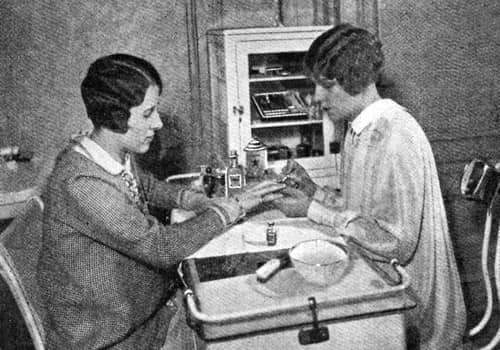
Above: 1937 Part of the fully equipped manicure test salon supervised by Miss Grace Thuma (right).
Beginning in 1936, Cutex began running advertisements directly comparing its polish with other brands using titles like ‘Does your Nail Polish get Thick and Gummy?’ and ‘Does your Nail Polish Peel or Chip?’ something it had not done before, a good indication that competition was increasing and its dominance was under threat.
In 1941, Cutex also redesigned its nail polish bottles. Copying an idea of Dura-Gloss it capped the bottles with a top that had the shade of the polish inserted into it.

Above: Cutex Nail Polish Bottles with colour inserts and Oily Polish Remover designed by Donald Deskey [1894-1989].
One anomaly in all this change was that Cutex kept promoting the idea that its nail polish should be applied so that the half moon and free edge were visible. This practice did not stop until 1939 when Cutex moved completely to cream polishes and fully painted nails. Given that Paris fashion had moved to the new style well before this, and Peggy Sage, another Northam Warren company, was doing the same back in 1930, why Cutex continued with this practice is mystifying. One possibility is that it was catering for its more conservative customers who bought nail polish through drug and variety stores. Another, is that highlighting the moon and free edge made the need for Cutex Cuticle Remover and Cutex Nail White more obvious.

Above: 1938 Cutex Polish Foundation, a base coat. The packaging is still promoting the idea that the polish should leave the nail moon (lunula) and free edge clear.
Wartime
Along with other cosmetics companies, Cutex experienced shortages during the war, as supplies of raw materials like nitrocellulose became difficult to get and manufacturing space was taken up by government contracts awarded to Northam Warren.
As far as I can tell there were no new products released by Cutex during the hostilities. Cutex did introduce new shades between 1940 and the end of the war including: Gadabout, Riot Red, and Rumpus (1940); Lollipop, Sugar Plum, Butterscotch, Gingerbread, Saddle Brown, Young Red, Sheer Natural, and Alert (1941); Black Red, and Sheer Natural (1942); On Duty, Off Duty and At Ease (1943); and Honor Bright (1944).
Post-war
Cutex continued to lose ground after the war. In 1943, Cutex was advertised as “The world’s favorite nail polish”, by 1956 it was “The world’s largest selling manicure aids”. By then, Cutex had largely relinquished its positions at the prestige end of the market and was relying primarily on sales in drug, grocery and syndicated stores like Woolworths and Kress which had customers that were very price sensitive.
Revlon was not content with being the dominant player in the market; Charles Revson wanted to bury every other competing brand. Revlon’s relentless colour promotions made it difficult for others to compete and when Revlon achieved a massive rating success with the television program ‘The $64,000 Question’ in 1955 their position became almost unassailable.
See also: Revlon and ‘The $64,000 Question’
In 1958, Revlon retailed lipsticks for upwards of US$1.35 and nail enamels for 65¢ and 75¢, while Cutex sold lipsticks for 35¢ and 79¢ and nail polishes for 35¢. Revlon was also making money from its extensive cosmetics range which supported its large advertising budget and allowed it to put additional pressure on retailers. Revlon’s prestige, range and margins were all higher.

Above: 1950 Cutex trying to persuade prestige buyers to switch.
Northam Warren countered as best it could. In 1946, they changed their advertising agency from J. Walter Thompson to Young & Rubicam, Inc. and then over the years went through a series of other agencies. By 1952, they were doing network television advertising and their print advertising became more like Revlon’s. They also responded to most of the cosmetic trends that affected them in the post-war period.
The 1950s were marked by the lipstick wars between Hazel Bishop, Coty and Revlon. In response to the success that Hazel Bishop had with their indelible Lasting Lipstick, Northam Warren, like other lipstick manufacturers of the period, also introduced an indelible lipstick, Cutex Stay-Fast (1952), sometimes using the tag “Never leaves a kissprint”. When ‘creaminess’ became a selling factor Northam Warren added lanolin to their indelible lipsticks and released Cutex Satin Cling Lipstick. They also produced a number of creamy formulations including Cutex Sheer Lanolin Lipstick (1955) and Cutex Delicate Lipstick (1959).
Like Helena Rubinstein, Revlon and others, Northam Warren also produced metal lipstick cases for Cutex lipsticks in the 1950s including: the Jewelled Case (1954), which came in a range of designs using a brass casing studded with imitation rubies, diamonds and/or sapphires; the Gold Mesh Case (1955), in 24 carat gold plate with an overall gold mesh design and a clear plastic base; the Designer Case (1958), with a range of coloured bands that could be matched with clothing or other accessories; and the Nugget Case (1959) in gold, studded with small gold nuggets.

Above: 1958 Cutex Designer Case. Based loosely on earlier designs by Helena Rubinstein and Revlon, the case did away with the ‘bullet look’ and came in a range of coloured stripes.
Cutex also made a number of additions and reformulations in its manicure lines. These included: Cutex Oily Quick Dry (1945), applied over the nail polish to speed up the drying time; Cutex Nail-Flex (1951), containing lanolin, cholesterol and white iodine to help prevent nails from becoming brittle and splitting; Cutex Cream Polish Remover (1954), said to dissolve polish in seconds and condition the cuticle as it did so; and Cutex Mira-base (1959), a base coat that did not have to dry before nail polish was applied.
Northam Warren also regularly updated its nail polishes and added new lines. Starting with Cutex Nail Brilliance (1947) containing ‘enamelon’ in eight shades, the company then added Cutex Pearl Brilliance (1950) and Cutex Chip-Pruf (1953). In 1957, the polishes were also reformulated to help reduce sedimentation, create a more uniform colour, give greater lustre to pearl forms and generally improve wear.
The nail polish bottle was not forgotten. The Nail Brilliance line originally came in a rather cylindrical bottle with a flat, white lid but the following year it was repackaged in a half-circular bottle with an elegant, tall brush handle extending from the top, an idea already used by Revlon. The bottle was said to be more luxurious but Cutex also dropped the price of the line from 29¢ in 1947 to 25¢ in 1948. Then, in 1951, Cutex introduced a new spill-proof bottle, simply called Spillpruf. It could be turned on its side without spilling because of a self-sealing apparatus in its neck.

Above: 1951 Cutex Spillpruf bottle.
The bottle neck design was also said to eliminate the possibility of picking up a large blob of polish which might drop off the brush. By the end of the year the Spillpruf neck was also being used in the Nail Brilliance and Pearl Brilliance lines although they still kept their tall brush handles.

Above: 1959 Cutex Spillpruf Overcoat and Nail Polish (Cameo shade).
Like other lipstick and nail polish producers Cutex introduced new colour shades each year including: Dark ’n Handsome, Confection Pink, and Play Red (1946); Applecart, Pippin and Look Pink (1947); Look Pink (1948); Here’s Your Cotton and Star Bright (1949); Cotton Candy, Pink Spangle, Prize Posey, and White Pearl (1950); Sugar Plum (1951); Strike Me Pink, Pink ’n Sassy, Pink ’n Sweet, and Red Hot ’n Blue (1952); Flaming Pearl (1953); Cute Tomata, So Tempting, Pink Scepter, and Royal Red (1954); Robins and Roses, and Slightly Scarlet (1955); Pink T.N.T. (1956); Coral Ice (1957); Hot Strawberry (1958); and Pink from Paris (1959). Many of these shades were pinks designed to appeal to the younger market that had developed after the war.
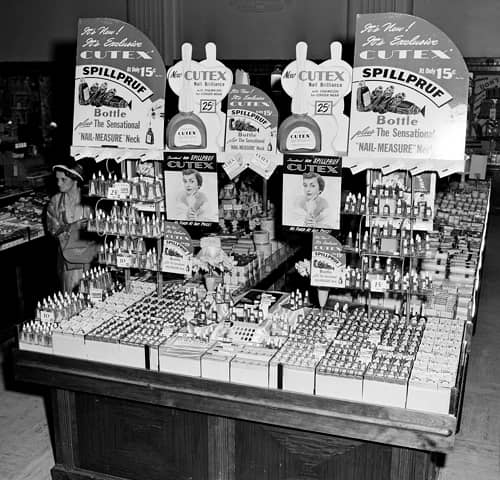
Above: 1951 Cutex Counter in a Texas department store.
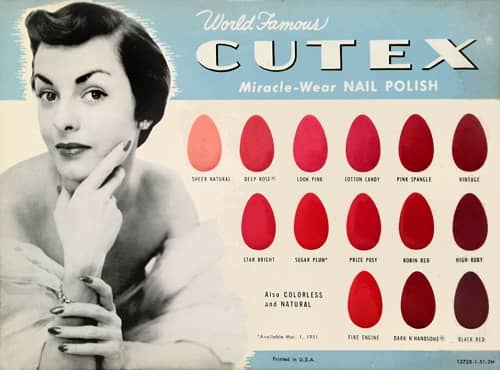
Above: 1951 Cutex Nail Polish shade range: Sheer Natural, Deep Rose, Look Pink, Cotton Candy, Pink Spangle, Vintage, Star Bright, Sugar Plum, Prize Posy, Robin Red, High Ruby, Fire Engine, Dark ’n Handsome, and Black Red.
In an attempt to boost sales Cutex even engaged in some cross-promotions. In 1953, as part of its Red Hot ’n Blue campaign, Cutex was aligned with a range of non-competitive products to set up displays under the slogan ‘That Beautiful American Look’. The upper part of the display was devoted to Cutex, the lower to the other products. It seemed to work, sales did improve after the promotion.

Above: 1953 Counter display for Cutex Red Hot ’n Blue shade promotion with non-competitive product tie-ins: Chlorodent Toothpaste, Lady Esther Four Purpose Cream, Lilt Home Permanent, Maybelline Make-up, Pacquin’s Silk ’n Satin Lotion, and Prell Radiant Shampoo.
Later developments
Cutex along with the other Northam Warren brands was sold to Chesebrough-Pond’s on December 30, 1960. The new owners were unable to do much to improve the fortunes of Cutex nor did Unilever which acquired Chesebrough-Pond’s in 1986.
See also: Chesebrough-Pond’s
In 1994, Unilever licensed Jean Philippe Fragrances to manufacture and market Cutex products in the United States and Puerto Rico. Sales were disappointing and when agreed targets were not met Jean Philippe relinquished their license enabling Unilever to sell their American interests in Cutex to Carson, Inc. in 1997 for US$41m.
By 1999, Carson was in financial difficulties and sold Cutex to an investment firm, The Shansby Group, for US$30m. In 2004, The Shansby Group and its joint venture partner Medtech Labs were acquired by the private equity firm GTCR Golder Rauner II, LLC and Cutex then became part of a holding company, Prestige Brands. The personal-care segment of Prestige Brands declined over time resulting in the company reducing its support and then eventually selling Cutex to Arch Equity Partners, in 2010. The new owners put it and Calico Laboratories – which manufactured nail polish removers – under a new business name, Cutex Brands.
In 1996, Unilever licensed Joh A. Benckiser GmbH to manufacture and market the Cutex brand in Europe and certain territories elsewhere. Cutex products in these territories were sold through Coty Beauty which Benckiser had acquired in 1992. In 2015, Cutex Brands was bought by Revlon and they followed this up by purchasing Cutex International from Coty in 2016 for US$29.1 million. The globally consolidated brand operates as a subsidiary of the Revlon Consumer Products Corporation.
Timeline
| 1911 | New Products: Cutex Cuticle Remover. |
| 1913 | New Products: Cutex Nail Powder Polishes; and Cutex Nail Bleach. |
| 1914 | New Products: Cutex Nail White. |
| 1916 | Cutex begins an advertising through J. Walter Thompson. New Products: Cutex Liquid Nail Enamel. |
| 1917 | Cutex product line repackaged in pink and black. |
| 1918 | New Products: Cutex Stick Polish. |
| 1919 | Subsidiary established in Montreal, Canada. New Products: Cutex Cold Cream. |
| 1922 | Formulation for Cutex Liquid Polish and Cutex Powder Polish improved. |
| 1926 | New Products: Cutex Polish Remover. |
| 1927 | Research manicure salon opened. New Products: Cutex Cuticle Cream; and Cutex Cuticle Oil. |
| 1928 | New Products: Perfumed Cutex Liquid Polish. |
| 1931 | Bakelite caps with inbuilt brush added to polish bottles. New Products: Cutex Nail White Pencil. |
| 1932 | New Products: Cutex Hand Cream. |
| 1933 | Cutex manicure sets redesigned. |
| 1934 | New Products: Cutex Crème Polish; and Cutex Oily Polish Remover. |
| 1935 | Cutex opens its first dedicated manicure salon in Chicago. New Products: Cutex Lipsticks. |
| 1936 | New Products: Cutex Oily Cuticle Remover; and Cutex Brittle Nail Cream. |
| 1938 | New Products: Cutex Polish Foundation. |
| 1939 | New Products: Cutex Nail Shampoo. |
| 1940 | New Products: Cutex ‘Porous’ Nail Polish. |
| 1941 | Cutex packaging redesigned. New Products: Cutex Overcoat. |
| 1945 | New Products: Cutex Oily Quick Dry. |
| 1947 | New Products: Cutex Nail Brilliance. |
| 1950 | New Products: Cutex Pearl Brilliance. |
| 1951 | Spillpruf bottle introduced. New Products: Cutex Nail-Flex. |
| 1952 | New Products: Cutex Stay-Fast indelible lipstick. |
| 1954 | Jewelled case added to the Cutex Stay Fast lipstick line. New Products: Cutex Cream Polish Remover. |
| 1955 | New Products: Cutex Satin Cling Lipstick; and Cutex Sheer Lanolin Lipstick. |
| 1958 | Cutex Designer Case for lipsticks debutes. |
| 1959 | Cutex Nugget Case for lipsticks added. New Products: Cutex Delicate Lipstick; and Cutex Mira-Base. |
| 1960 | Chesebrough-Pond’s buys Northam Warren. |
| 1987 | Chesebrough-Pond’s acquired by Unilever. |
| 1996 | Coty Beauty (Benckiser) acquires the rights to manufacture the Cutex brand in Europe and certain territories elsewhere from Unilever. |
| 1997 | Cutex (American and Puerto-Rican) business acquired by Carson, Inc. from Unilever. |
| 1999 | Cutex nail polish remover business (American and Puerto-Rican) acquired by the investment firm, The Shansby Group. |
| 2004 | Cutex (American and Puerto-Rican) sold to GTCR Golder Rauner II, LLC, a private equity investment firm and becomes part of Prestige Brands. |
| 2010 | Arch Equity Partners, investment group acquired Cutex (American and Puerto-Rican) and placed it under a new business name, Cutex Brands. |
| 2015 | Cutex Brands acquired by Revlon. |
| 2016 | Revlon buys by Cutex International from Coty Beauty. |
First Posted: 26th November 2019
Last Update: 27th February 2024
Sources
The American perfumer & essential oil review. (1906-1955). New York: Robbins Perfumer Co. [etc.].
The chemist and druggist. (1859-) London: Morgan Brothers.
Bliven, B. (1917). Creating a special class of salesmen to handle unusual type of customer. Printers Ink, 48(12), 37-40, 45.
The drug and cosmetic industry. (1932-1997). New York: Harcourt Brace Jovanovich [etc.].
Forde, K. (2002). Celluloid dreams: The marketing of Cutex in America, 1916-1935. Journal of Design History, 15(3) 175-189.
Jones, G. (2010). Beauty imagined: A history of the global beauty industry. Oxford: Oxford University Press.
J. Walter Thompson Co. (1916). News bulletin, no 2. New York: Author.
Kane, M. (1946). Northam Warren, pioneer in manicure field. The American Perfumer & Essential Oil Review, February, 43-44.
Kavanagh, J. A. (1923). A manicure specialty romance. Northwestern Druggist, 31, 132-133.
McKenna, E. (1920). Shall we put the line in uniform? Printers Ink, December, No. 24, 5-6.
Nail enamel. (1959). Drug and Cosmetic Industry. 84(4), 458-459.
Sutton, D. H. (2009). Globalizing ideal beauty: How female copywriters of the J. Walter Thompson advertising agency redefined beauty for the twentieth century. New York: Palgrave Macmillan.
Warren, N. (1921). Package design a factor in establishing a new habit. Printers Ink, 3(2), 19-20.
Warren, N. (1922). How a great toilet goods business was built. The American Perfumer & Essential Oil Review, November, 393-394, 419.
Warren, N. (1933). Manicure. The Hairdresser and Beauty Trade, September, 12.

Northam Warren [1878-1962] aged around 45.

1912 Cutex Cuticle Remover. This is the earliest advertisement for Cutex I have found. It appeared in the Evening World, New York on March 27, 1912. There is no mention of Northam Warren.

1914 Cutex trade advertisement.

1915 Cutex Nail Polish Cake and Nail White.

1916 The first Cutex advertisement designed by the J. Walter Thompson advertising agency. It appeared in The Chicago Tribune on the 4th June, 1916. An internal memo from the J. Walter Thompson Company suggests it was very successful: “We think we have done this pretty well in this first advertisement, because in his mail Tuesday morning, the advertiser received 350 requests for samples, each with 10 cents enclosed. By Monday of this week, he had received 1800, which brought the cost per Inquiry down to 9 cents. This is a remarkable figure, and is the lowest cost we have ever had on newspaper advertising.”
(J. Walter Thompson Co., 1916).
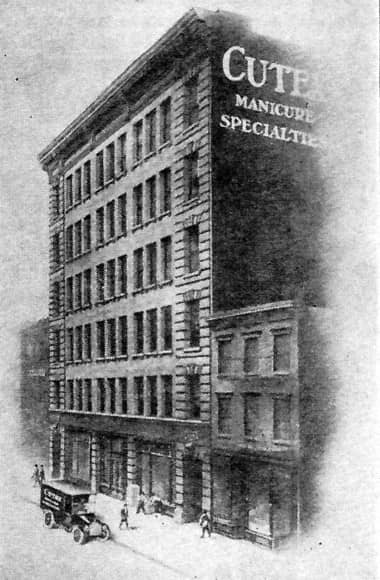
The Cutex Building on West 17th Street, New York.

1918 Cutex with new pink and black packaging designed by the J. Walter Thompson Company.

1919 Cutex products sold through Henry C. Quelch & Co., London.
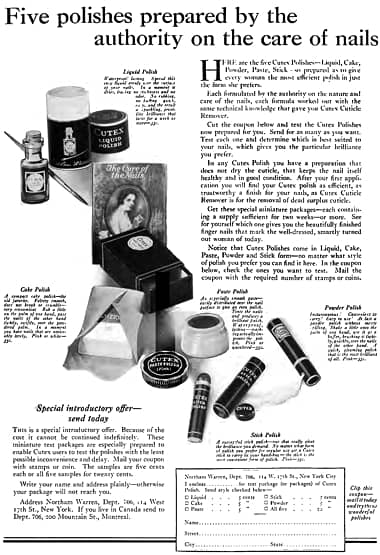
1921 Cutex. There were by 1918 five nail polishes in the Cutex range: liquid, cake, paste, powder and stick.
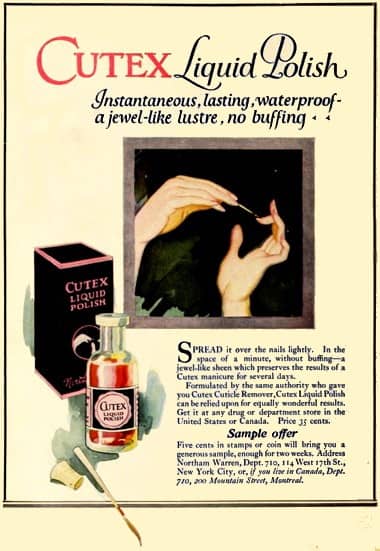
1921 Cutex Liquid Polish in the original Natural (pink) shade with separate brush.
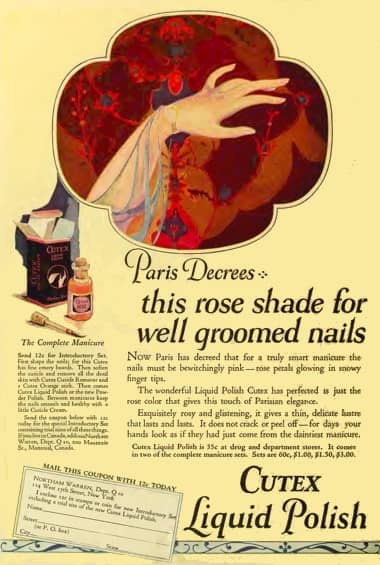
1924 Cutex Liquid Polish Rose shade.

1924 Cutex Manicure Sets.

1924 Cutex Liquid Polish (France).
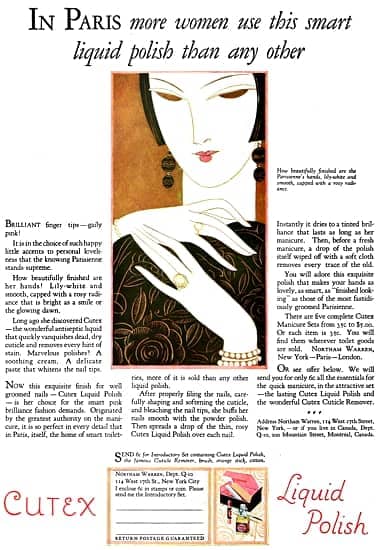
1925 Cutex Liquid Polish.
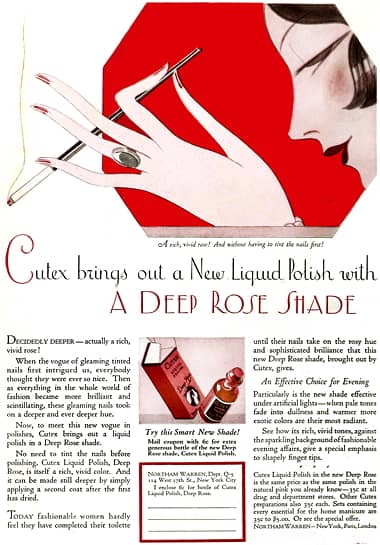
1926 Cutex Liquid Polish, Deep Rose shade.

1926 Cutex (Vienna).

1927 Cutex Manicure Sets.

1927 Cutex Liquid Polish in Natural and Deep Rose shades. The bottles shown are sample packs.
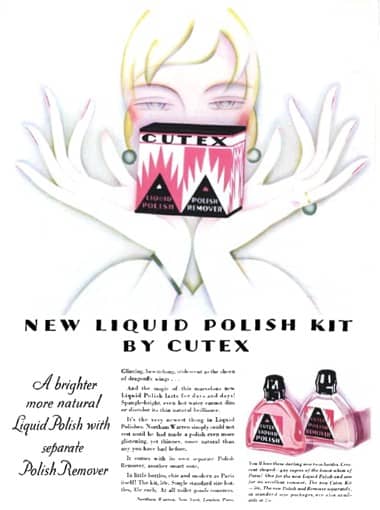
1927 Cutex Polish Kit containing Cutex Liquid Polish and the new Cutex Polish Remover added to the line that year.
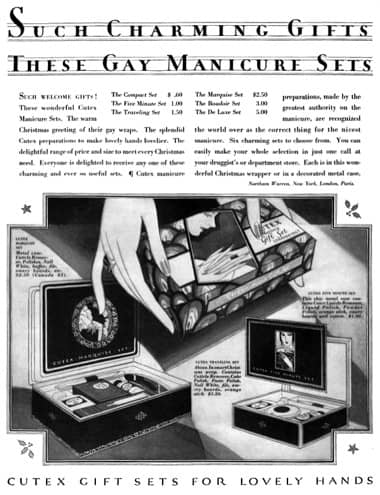
1927 Cutex Manicure Sets.
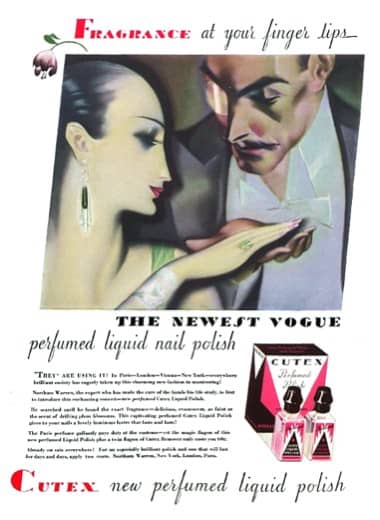
1929 Cutex Perfumed Liquid Nail Polish in a new bottle shape.
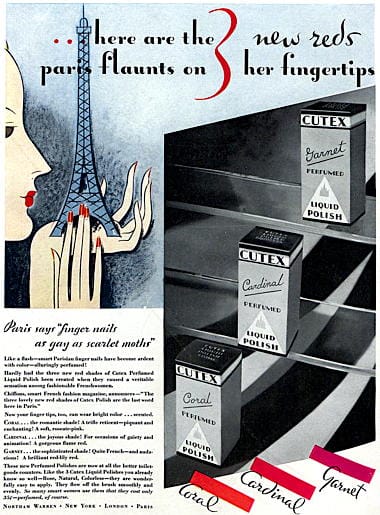
1930 Cutex new reds.
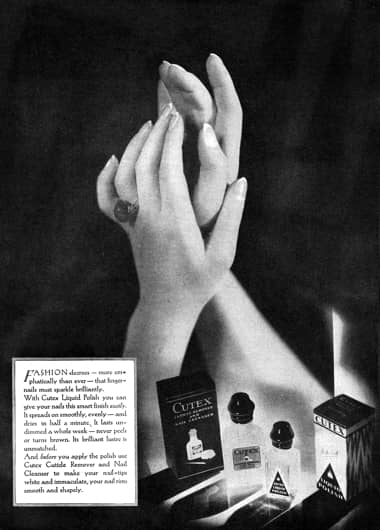
1931 Cutex Cuticle Remover and Liquid Polish.

1932 Cutex Nail Polish with Bakelite cap and fitted brush.

1932 Cutex Liquid Polish explaining how to paint the toenail. The use of nail polish on toes became fashionable on the beaches of Europe around 1930.
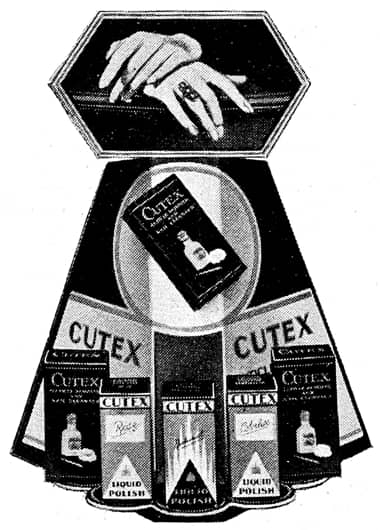
1932 Cutex counter display (Britain).

1933 Cutex Liquid Polish with the Cutex Color Wheel to match Cutex shades with the colour of clothing.

1934 A French advertisement for Cutex products. By now Cutex was well established overseas.

1935 Cutex Liquid Polish and four matching lipsticks in Natural, Coral, Cardinal, and Ruby shades. The lipstick cases were the rectangular push-up type.
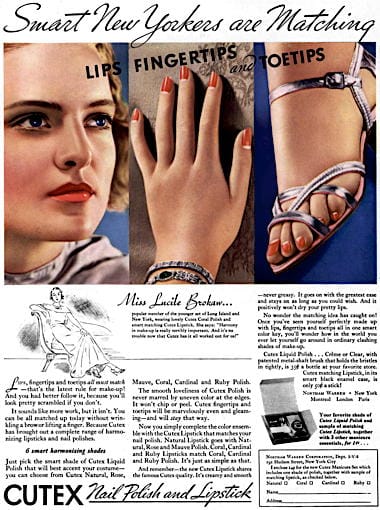
1935 Cutex Matching lips fingertips and toetips.

1936 Cutex ‘Smoky’ shades.
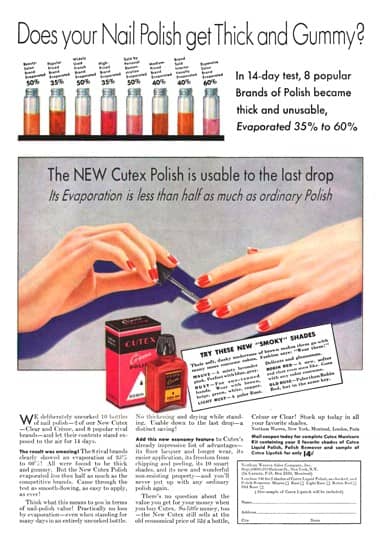
1936 Cutex nail polish comparison.

1937 Cutex nail polish chipping comparison.
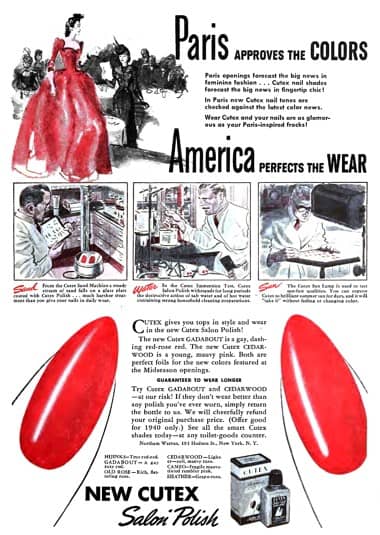
1940 Cutex Salon Polish.

1941 Cutex Oily Cuticle Remover.

1941 Cutex Porous Nail Polish in new packaging designed by Donald Deskey and had a tapering white top with the shade of the polish inserted.

1943 Cutex On Duty shade.

1948 Cutex Nail Brilliance Nail Polish.

1952 Cutex Spillpruf bottle.

1953 Cutex Pink ’n Sassy and Pink ’n Sweet shades. These were expected to appeal to a younger market.
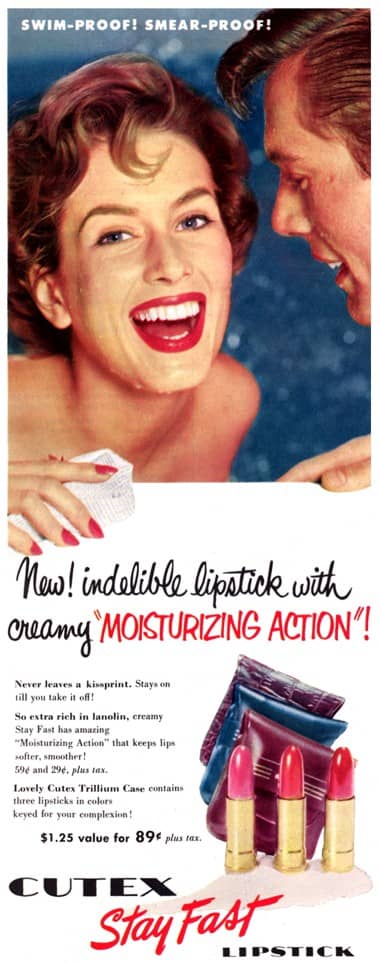
1953 Cutex Stay Fast Indelible Lipstick.
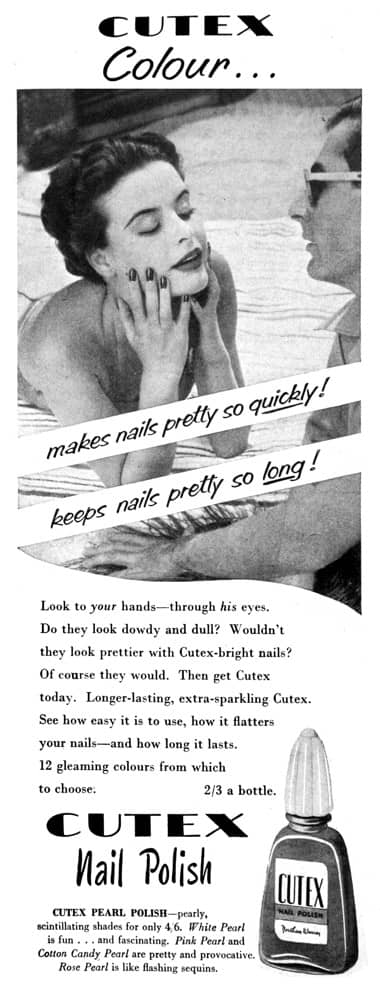
1954 Cutex Pearl Polish (Britain).

1955 Cutex Robins and Roses shades.
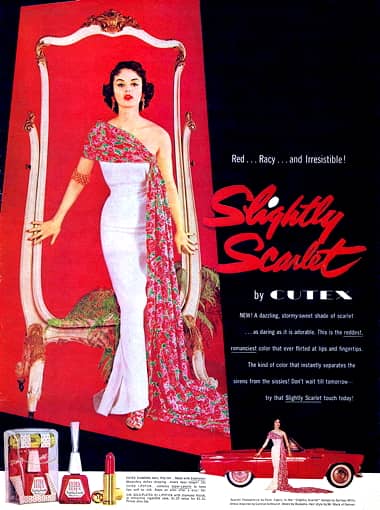
1955 Cutex Slightly Scarlet.

1956 Cutex Sheer Lanolin Lipstick and matching Diamond Cutes Nail Polish in 10 shades.

1958 Cutex Polish Remover acetone free.
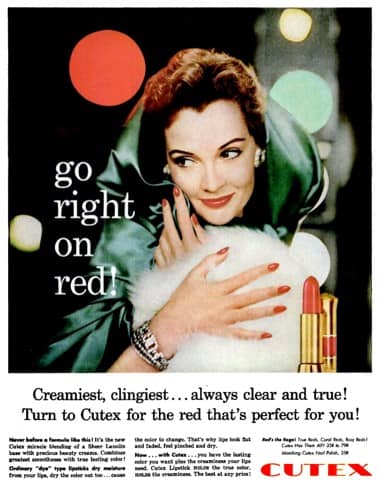
1958 Cutex Go Right on Red.
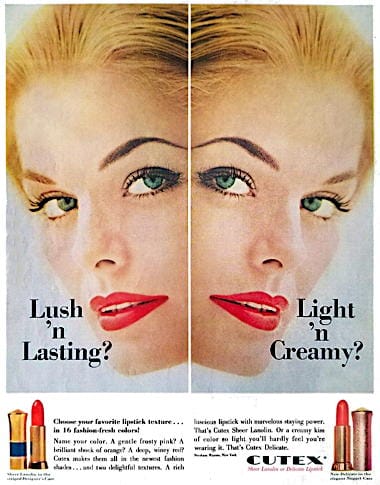
1959 Cutex Sheer Lanolin Lipstick in the striped Designer Case and Cutex Delicate Lipstick in the Nugget Case.
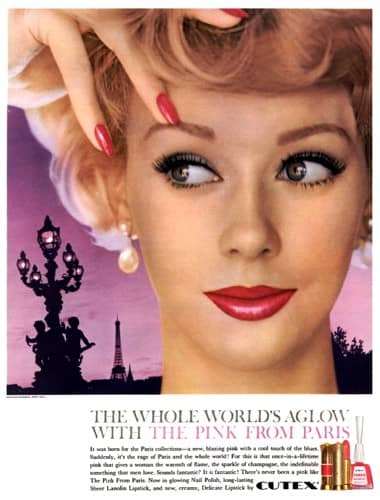
1959 Cutex Pink from Paris.

1960 Cutex Exotic Pearl Nail Polish in Orange Blaze, Jamaica Green, Tahiti Orchid and Coral Sand shades.
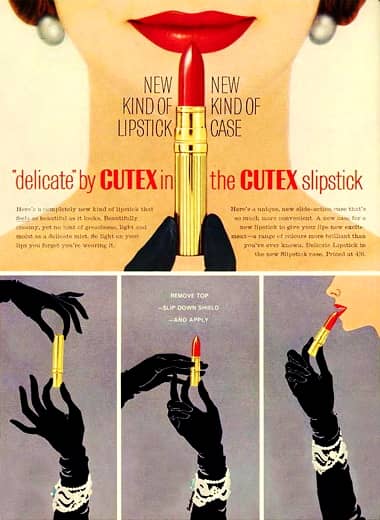
1960 Cutex S’lipstick with a novel action. The cap was removed and after it was attached to the base the shield was slipped down revealing the lipstick.
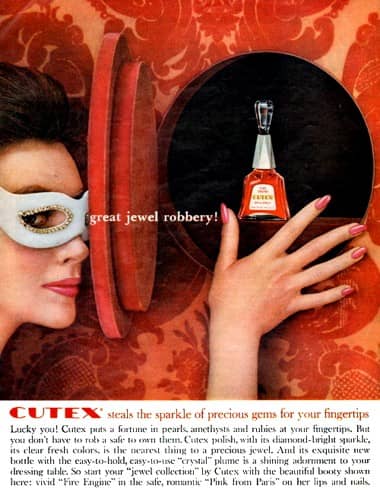
1961 Cutex Nail Polish in another new bottle.
